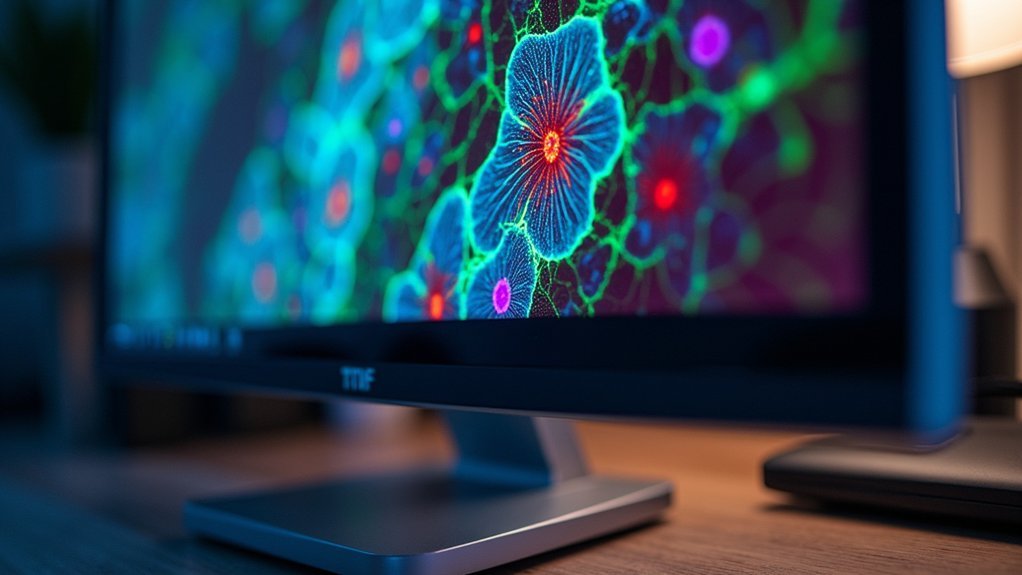For confocal imaging, proprietary formats (CZI, LIF, ND2) best preserve complete datasets with all metadata, while TIFF serves as the gold standard for sharing and analysis. You’ll want to maintain your original proprietary files for reference and use TIFF for compatibility with analysis software. TIFF supports high bit-depth (up to 16-bit) and lossless compression, ensuring your quantitative measurements remain accurate. Discover how proper format selection protects your research integrity and analysis precision.
Understanding Confocal Image Data: Pixels and Metadata
The foundation of confocal imaging lies in its dual nature of data: pixels and metadata working together to create meaningful scientific representations.
Scientific imagery’s power emerges from the symbiotic relationship between visible pixels and their invisible contextual metadata.
When you capture a confocal image, each pixel value represents light intensity at a specific location in your specimen. But these pixels alone tell only part of the story. The metadata—information about image dimensions, bit depth, pixel sizes, and acquisition settings—provides vital context for accurate interpretation of your results.
Proprietary formats like .czi and .lsm preserve this complete dataset, whereas conversion to standard formats risks losing valuable metadata. You’ll want to maintain original files to guarantee reproducibility and accuracy in your analysis.
For publication and sharing, TIFF files offer a good compromise, retaining both pixel information and essential metadata without significant loss.
Proprietary Formats: CZI, LIF, ND2, and Other Manufacturer Formats
When working with confocal microscopy, proprietary file formats like CZI, LIF, and ND2 serve as digital containers that preserve both your image data and essential metadata.
These formats excel at storing multi-dimensional datasets, including z-stacks and time-lapse sequences vital for thorough analysis.
You’ll find these proprietary formats retain critical acquisition settings and calibration information that standard formats might lose. For quantitative research, formats like CZI offer superior precision in intensity measurements.
While you’ll typically need manufacturer software to fully access these files, you can export to TIFF for publication purposes.
For scientific reproducibility, it’s best to maintain your data in these native proprietary formats throughout your analysis workflow, ensuring all relevant experimental parameters remain intact for future reference.
TIFF Format: The Gold Standard for Scientific Images

TIFF format stands as microscopy’s gold standard because it preserves your image data without compression losses while maintaining critical metadata like microscope settings and acquisition parameters.
You’ll benefit from TIFF’s ability to store high bit-depth information (up to 16-bit), ensuring all 4096 grey levels from your confocal system remain intact for quantitative analysis.
When you export images in TIFF format, you’re guaranteeing compatibility with analysis software while maintaining the scientific integrity needed for publication and reproducible research.
Lossless Data Preservation
Because scientific imaging requires absolute precision and data integrity, lossless file formats stand as the foundation of reliable confocal microscopy. When you save your confocal images, TIFF format preserves every pixel value exactly as captured, unlike lossy formats like JPEG that sacrifice data for smaller file sizes.
TIFF’s capacity to store up to 16 bits per pixel allows you to capture 65,536 discrete gray levels—essential for quantifying subtle fluorescence intensity variations. This lossless compression approach guarantees you’re analyzing genuine biological signals rather than compression artifacts.
The format also retains critical metadata about microscope settings and acquisition parameters, supporting experimental reproducibility. Since confocal systems typically record 12 bits of meaningful data within a 16-bit container, you’ll maintain complete data integrity while guaranteeing compatibility across analysis platforms.
Metadata Retention Capabilities
Among all image formats available to researchers, the TIFF format stands unrivaled in its ability to preserve essential metadata alongside pixel values. When you’re working with confocal imaging data, you’ll find TIFF’s metadata retention capabilities particularly valuable for scientific reproducibility and thorough analysis.
TIFF offers distinct advantages for preserving your imaging context:
- Stores tagged information critical for microscopy, including objective specifications and exposure settings
- Preserves 12-bit confocal data within a 16-bit format, maintaining enhanced grey levels for precise intensity measurements
- Retains complete metadata integrity, unlike JPEGs and PNGs which sacrifice this vital contextual information
- Guarantees your valuable metadata remains accessible for future analyses, facilitating accurate interpretation of research findings
Scientific Analysis Benefits
The scientific validity of your confocal imaging data hinges directly on file format selection. When you choose TIFF format, you’re securing the gold standard for quantitative image analysis in microscopy research.
TIFF preserves up to 65,536 grey levels with 16-bit depth capacity, while typical confocal systems retain 12-bit data within these files. This precision is critical when measuring subtle intensity differences in your specimens.
Unlike JPEG’s lossy compression that permanently discards data, TIFF’s lossless nature prevents any loss of information that could compromise your measurements.
Beyond pixel values, TIFF safeguards essential metadata including bit depth and microscope settings. This context is indispensable for result interpretation and experimental reproducibility.
Without proper metadata, your measurements may yield incorrect conclusions, undermining the scientific rigor of your research.
Bit Depth Considerations for Quantitative Analysis

When performing quantitative analysis on confocal images, your choice of bit depth becomes critically important. Higher bit depths capture subtle fluorescence intensity variations that lower resolutions simply can’t detect.
For reliable quantitative assessments, you’ll want to:
- Use 16-bit TIFF files to preserve the full 4,096 gray levels from 12-bit confocal data.
- Avoid converting single-channel images to 8-bit, as this causes irreversible loss of intensity information.
- Maintain the original bit depth throughout your analysis workflow to guarantee measurement reliability.
- Remember that 16-bit formats support a dynamic range of 65,536 gray levels, essential for detecting minute differences.
Lossless vs. Lossy Compression in Microscopy
Choosing between lossless and lossy compression formats greatly impacts the integrity of your confocal microscopy data. When you’re conducting quantitative analysis, every pixel value matters.
TIFF files with lossless compression preserve all original image data, maintaining the complete dynamic range of your 12-bit or 16-bit images. This preservation is critical when you’re measuring cellular structures or analyzing fluorescence intensity values with precision.
In contrast, JPEG and other lossy formats simplify pixel values and introduce artifacts that can compromise your analysis. These alterations might be imperceptible visually but can notably affect numerical measurements.
For scientific microscopy applications where accuracy is paramount, always opt for lossless compression formats. They guarantee your metadata remains intact and your intensity measurements stay reliable for future analysis.
Managing Large Datasets: Virtual Stacks and Memory Optimization

Modern confocal microscopy generates massive multi-dimensional datasets that can quickly overwhelm your computer’s RAM during analysis.
Virtual stacks offer an elegant solution by loading only the currently viewed slice while keeping the rest on your hard drive.
To optimize memory when working with large datasets:
- Use the “File → Import → TIFF Virtual Stack” option or LOCI Bioformats plugin for seamless integration
- Reduce bit-depth when full dynamic range isn’t critical for your analysis
- Consider cropping regions of interest rather than loading entire datasets
- Separate channels to work with one fluorophore at a time
Be careful when processing virtual stacks—modifications mightn’t be preserved when traversing between slices, so save your work frequently to prevent data loss.
Preserving Spatial Information and Calibration Data
You’ll need to maintain accurate voxel dimensions when exporting confocal data, as these measurements directly impact your spatial analysis results.
Proprietary formats like .czi and .lsm preserve these critical calibration parameters, while conversions to JPEG or PNG will strip away this essential metadata.
When preparing images for publication, integrate scale bars directly into your TIFF exports to guarantee spatial context remains intact for viewers who don’t have access to your original files.
Subheading Discussion Points
Three vital aspects of confocal image data must be preserved during file conversion: spatial information, calibration parameters, and associated metadata. When you export your images, choosing the right format guarantees your original data remains intact for analysis and publication.
Consider these essential points:
- Proprietary formats (.czi, .nd2) contain embedded spatial calibration data essential for accurate measurements.
- TIFF files preserve both pixel values and metadata, maintaining spatial relationships for reliable analysis.
- Lossy compression formats like JPEG can introduce artifacts that compromise spatial information.
- Whenever possible, retain your original acquisition format to guarantee all calibration data remains accessible.
Remember that spatial information isn’t just about pixels—it’s fundamental to the scientific validity of your confocal imaging work.
Voxel Dimensions Matter
When working with confocal microscopy, accurate voxel dimensions represent the foundation of reliable spatial analysis. Your 3D image’s spatial resolution directly impacts measurement accuracy and structural interpretation—making proper calibration data essential for translating pixel measurements into real-world distances.
TIFF files excel at preserving these critical voxel dimensions along with associated metadata. When you’re exporting confocal images, you’ll want to maintain original voxel dimensions to guarantee subsequent analyses reflect true spatial relationships within your specimen.
Be cautious during format conversion, as losing voxel dimension information can lead to serious misinterpretations of your data. By choosing formats that retain this spatial information, you’re safeguarding the integrity of your research and guaranteeing that your measurements accurately represent the biological structures you’re studying.
Scale Bar Integration
Properly integrated scale bars serve as critical visual references that transform abstract pixel measurements into meaningful real-world dimensions.
When adding scale bars to your confocal images, you’ll want to maintain spatial accuracy and metadata integrity.
To guarantee reliable scale bar integration:
- Use TIFF format to preserve essential metadata including pixel size and spatial calibration information.
- Verify that your scale bar dimensions accurately correspond to the pixel dimensions of your original image.
- Export images with scale bars in 24-bit RGB TIFF for publications requiring overlays with visual clarity.
- Avoid lossy formats like JPEG which can compromise the precise spatial information needed for accurate scale representation.
File Format Compatibility With Analysis Software
Although researchers often capture confocal images in proprietary formats from manufacturers like Zeiss and Leica, these formats don’t always play well with standard analysis software.
While these proprietary formats contain valuable metadata, they can limit your analysis options and increase file size considerably.
You’ll want to export your images as TIFF files for both publication and analysis. TIFF preserves pixel data and essential metadata while maintaining compatibility with analysis programs like CellProfiler.
Free software options such as FIJI can help you view and convert proprietary formats without losing data integrity.
Avoid converting to PNG for serious analysis work, as you’ll lose important metadata.
For consistent intensity measurements across different analyses, stick with TIFF and always retain your original files as a reference.
Best Practices for Long-Term Data Storage and Sharing

Since confocal imaging generates massive amounts of data, implementing robust storage and sharing practices is essential for research integrity.
To guarantee your valuable microscopy data remains accessible and usable over time, consider these best practices:
- Save in TIFF format for long-term storage, as it preserves both pixel data and critical metadata while maintaining universal compatibility.
- Use lossless compression when saving file formats to reduce size without compromising data integrity.
- Create regular backups of both proprietary formats (.czi, .nd2) and universal formats to protect against software obsolescence.
- Include supplementary documentation with shared data that describes imaging conditions, metadata, and analysis parameters to improve reproducibility.
These practices will guarantee your confocal imaging data remains accessible and scientifically valuable for years to come.
Frequently Asked Questions
What File Format Has the Best Image Quality?
For the best image quality, you’ll want to use TIFF format with 16-bit depth or proprietary formats like CZI and ND2. They’re lossless and preserve all pixel values and essential metadata.
What File Format Do Digital Cameras Use?
Digital cameras primarily use JPEG for everyday shooting, but they’ll also offer RAW formats (like CR2 or NEF) for professional-quality images. Some cameras support TIFF or PNG for lossless image storage.
What Is the Best Image Format for Scaling?
For scaling, TIFF is your best format choice. It preserves raw data and metadata, ensuring accurate intensity measurements. You’ll avoid information loss that occurs with 8-bit formats when scaling your scientific images.
What Is TIFF Format Used For?
You’ll find TIFF format is used for microscopy and scientific imaging where data integrity is vital. It preserves all image data losslessly, maintains high bit depths, and stores essential metadata for accurate analysis.
In Summary
For confocal imaging, you’ll get the best results using lossless formats like TIFF that preserve your full bit depth and metadata. While proprietary formats (CZI, LIF, ND2) offer extensive data retention, they may limit your analysis options. Always consider your analysis software compatibility, storage capacity, and long-term accessibility needs. Remember to back up your raw data files and document your acquisition parameters for reproducible research.





Leave a Reply